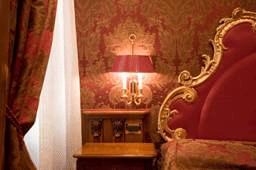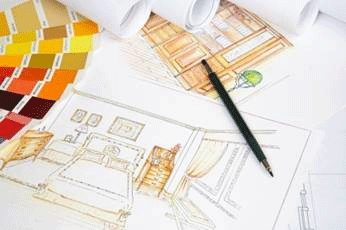How to interior design a period property
A successful interior is one that comfortably blends the twenty-first century with a sensitivity for the period style, without descending into period pastiche.

It is very rare to find a period home that does not retain at least some of the original detail and features of the era. Start by keeping the architectural ‘bare bones' of the house such as ceiling height, cornicing, original flooring and fireplaces. If your house is a listed property there are various restrictions on what you can and cannot do, so best to contact your local planning authority before making any plans.
I have found that the most important "friend" for an interior designer is the architectural salvage yard where you can search out missing door knobs, radiators, stonework etc. and even add your own architectural features in keeping with the period style. These details are key to retaining that period feel and atmosphere. Check the directory on www.salvo.co.uk for salvage yards.

So where to look for sources of inspiration? Whilst a good place to start, don't get too caught up in the glamorous schemes and ‘design' must-haves of the glossy magazines. Inspiration can come from the most unlikely of places. History books, museums, postcards, household archives of course, and anything that takes your fancy can all contribute to a design. Try not to think of the rooms you are re-designing as rectangles to be filled with furniture. All rooms should have a focal point to add atmosphere and personality. It can be a period fireplace, the stucco plasterwork on the ceiling, family heirlooms or an art collection. Space planning is even more important in a period home than a modern one. The layout is often very different to today's requirements with sometimes oddly shaped rooms, doors hinged on the opposite side (for discretion), fewer bathrooms and toilets and often very small kitchens.
First and foremost one needs to think about the needs of the household - this is an analysis of function. What will you use each room for and what elements are important for you and the family? Do you need a relaxation area, entertaining space, storage, work space, staff accommodation?
When space planning make sure you include your favourite pieces of furniture or objects at the beginning of the process, otherwise you might find that by the time the project is finished, that favourite chair or curtain material just does not fit with the rest of the scheme. Most rooms dictate their orientation and focus. Rarely will you find a room that can support two or more alternative layouts, so furniture placement is most important and should be your first consideration. Make full size templates of your furniture from newspaper and move them around the room to see what works best. Try moving around the ‘furniture' to see if you have enough room. This is particularly important in smaller period cottages with low beams and odd angles. Don't forget to allow for side tables, plants etc.
Scale is important, and if you have small rooms do not automatically choose the smallest patterns or smallest furniture. Use larger, bolder designs and a few key pieces of furniture. Scaling up visually pushes back the walls and ceilings. In large rooms scale is already present, so creating activity-specific areas is a good trick. Create a warm and inviting entertaining area around the fireplace, a reading area near the windows with books shelving on one wall, or even a card playing area.

These principles hold true for any interior design analysis. The difference for period properties is that the period elements themselves (the walls, the ceiling, the cornice) need to be considered in the same way you would consider your furniture or your paintings. They are equally important elements in your design scheme. This is where space planning is paramount.
Exquisite houses, the beauty of Nature, and how to get the most from your life, straight to your inbox.
And so to lighting. How best to illuminate the rooms with natural daylight and electric lighting? Remember that lighting needs to be present at three different levels; low level, middle and high level. Lighting needs to be softer in the rooms you live in and much brighter in rooms you work in such as the kitchen or bathrooms. Dimmers are always a good addition. Old fashioned pendant chandeliers in grander houses can look very flat if too brightly lit so this central source of lighting needs to be dimmed and low level lighting as well as mid-level illumination is needed to provide different moods. Don't shy away from using modern lighting in period homes, the contrast of fixtures can really enhance the architectural features and concealed lighting is fantastic to highlight a beautiful ceiling or wall panelling.

Colour and fabric choice are important in dressing the rooms, even more so in a period home. There are no hard and fast rules as colour is a personal choice, but I find it works best when the rooms have a sense of harmony and the colour flows throughout the house. I personally find that it is best to leave paint colour until last, as this allows me to tweak the mood and tone of the rooms according to the client's existing fabrics and furniture. One good rule is to restrict your colour palette to one or two shades, add variations on these and contrast with one other colour to highlight certain items.

Don't slavishly match paint colours or fabric patterns. When planning your room decoration either match traditional, printed fabrics and wallpapers with contemporary plain weaves and texture to balance the scheme out. If using plain monochromes a careful juxtaposition of one or two striking bold patterns, such as a rough, textured antique linen next to a colourful silk, will ensure your home is striking, elegant and oozes period charm without falling into pastiche. If in doubt keep it simple and let your period home do the talking...
Françoise is running a course: ‘Interior Design for a period home" on 6th May 2010.
Françoise Murat & Associates. Interior Designers. Landscape Designers.
* Francoise Murat, who shot the photographs for this article, runs Francoise Murat & Associates, a registered business in ProjectBook.co.uk's Heritage Register. Francoise is running a course: ‘Interior Design for a period home' on 6th May 2010. Further details can be found in the ProjectBook events section.
* For more on period buildings and gardens, and how to take care of them, visit www.projectbook.co.uk where you can find the Heritage Register - a service helping period property owners to locate vetted craftsmen, contractors and consultants, along with a comprehensive range of specialist resources relevant to historic properties.
Country Life is unlike any other magazine: the only glossy weekly on the newsstand and the only magazine that has been guest-edited by His Majesty The King not once, but twice. It is a celebration of modern rural life and all its diverse joys and pleasures — that was first published in Queen Victoria's Diamond Jubilee year. Our eclectic mixture of witty and informative content — from the most up-to-date property news and commentary and a coveted glimpse inside some of the UK's best houses and gardens, to gardening, the arts and interior design, written by experts in their field — still cannot be found in print or online, anywhere else.

